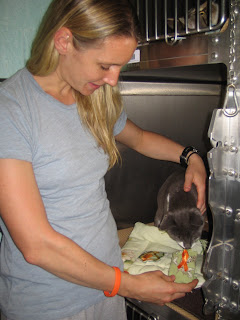UPDATE on The Mother's Comfort Project
We made 40 beds yesterday (Saturday) with HEART (Humane Education Advocates Reaching Teachers) and some awesome volunteers, along with 20 new cat toys! In the picture here you'll
 see HEART coordinators, Gage, a 7-yr old student, and Sadie, our Director's adopted pit bull, who she met on a delivery trip for the Mother's Comfort Project last year!
see HEART coordinators, Gage, a 7-yr old student, and Sadie, our Director's adopted pit bull, who she met on a delivery trip for the Mother's Comfort Project last year!Delivery of our beds and toys from yesterday and from our April public event is set for next Saturday, June 6th. We're so excited!
Having delivered over 700 beds to the Brooklyn Animal Care and Control shelters, we're very proud of our work and diligence in making shelter life for animals a little more comfortable. We add a touch of love to every bed and cat toy, and we believe each animal we bestow these gifts to feels it.
The Mother's Comfort Project was recently featured in Time Out New York as "Cause of the Week"!!
Here are some things Sharon Steel of TONY asked me and my answers to them. The below gives an insider's insightful view of the real meaning behind the project.
What has the experience meant to you -- both in terms of sewing the beds themselves, and delivering them to the shelters for the animals in need?

I like the social aspect of it- we talk about a lot of animal awareness and related issues while at the sewing and fabric tables. We share funny stories about our dogs and cats, and it's also a great way to meet potential volunteers for our other media and outreach projects. In addition, Patti Gilstrap, co-owner of Flirt, has been amazing in hosting the monthly event and helping everyone with the sewing machines. We would never have had nearly the success we've had if it wasn't for Flirt and the owners there.
Visits to the Brooklyn AC&C to deliver the beds is the best part of this project. I have cats but love all animals, so I welcome the chance to interact with the dogs, in addition to cats. When I see dogs with scars on their face, head, body, and I can tell it is from dog fighting, I am reminded that this form of animal cruelty is still very much a reality and must be stopped...and then it just amazes the heck out of me that they are also the sweetest animals, full of vitality and personality. It is not what most people expect but that's the reality. Dogs are truly amazing animals!
I also know that many of the dogs and cats we meet will get a chance at a better life in a new home with a new family. Some cage signs will have "Adopted" printed on them, so going to the shelter and seeing that is really rewarding since so many of us and others in rescue and awareness work so hard to educate people on shelter and rescued animals and that adoption is the only option.
So in summary, the bed delivery gives us a chance to see the reality of the homeless animal population first hand and to also see that the animals for adoption at the AC&C shelters are beautiful, wonderful companions that would thrive in a person's home. I take that with me, use these personal experiences in conversation with others whenever I can.
One specific anecdote would be wonderful. For example, did you develop special bonds with any of the animals you brought beds to?

When Susan and I went a few months ago, we saw a chicken. He was in one of the cages (a different room from the dogs, cats) and looked like he was in rough shape, pretty sad. We gave him a bed, though. I have always loved farm animals as well as cats and dogs, so I was glad to have an opportunity to show a little love to one. All animals should be treated well, taken care of, including farm animals, of course.
Some volunteers also feel compelled to adopt after they see the animals. Has that happened to you as well?
Not really -- I know I have a full house, and my main focus is on the public, people who want a pet and may not know much about adoption, where to go, or may be susceptible to going into a puppy/kitten shop. Some day I'll have a house and a big yard, and then I will definitely adopt a big dog!We take many pictures every time we go and we can share them with people via the website or other online mediums. I think it helps for the public, including our friends and family, to see pictures of people just like them interacting with animals in a shelter, especially larger dogs which may seem intimidating to some people at first. I think photos like this can help shift one's image of a city shelter, which is certainly part of what we do.
Finally, why do you think TONY readers should care and get involved, perhaps donating their time to delivering beds or their own sewing skills to the project?
There is no other project like this around NYC -- draws on people's creativity and compassion for animals. Plus each bed is made by an individual -- so it's like a gift from you, if you were to participate, to a shelter animal. It's very personal, and we always take tons of pictures so everyone can see how their work is directly helping animals -- and people. The beds are a great contribution to the staff and volunteers at AC&C. They can wash and reuse the beds, and they do not have the budget to purchase such durable quality beds for the animals. They are very grateful and express it every time we're there.
---------


.jpg)







